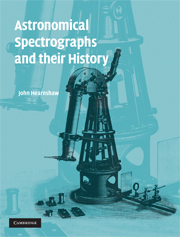Book contents
- Frontmatter
- Contents
- Preface
- Acknowledgements
- 1 The historical development of astronomical spectroscopes and spectrographs
- 2 The theory of spectroscopes and spectrographs
- 3 High resolution spectrographs
- 4 Solar spectrographs and the history of solar spectroscopy
- 5 Objective prism spectrographs
- 6 Ultraviolet and nebular spectroscopy
- 7 Multi-object spectrographs
- 8 Ten pioneering spectrographs of the late twentieth century
- Figure sources and acknowledgements
- Name index
- Subject index
2 - The theory of spectroscopes and spectrographs
Published online by Cambridge University Press: 07 September 2010
- Frontmatter
- Contents
- Preface
- Acknowledgements
- 1 The historical development of astronomical spectroscopes and spectrographs
- 2 The theory of spectroscopes and spectrographs
- 3 High resolution spectrographs
- 4 Solar spectrographs and the history of solar spectroscopy
- 5 Objective prism spectrographs
- 6 Ultraviolet and nebular spectroscopy
- 7 Multi-object spectrographs
- 8 Ten pioneering spectrographs of the late twentieth century
- Figure sources and acknowledgements
- Name index
- Subject index
Summary
GENERAL PROPERTIES OF A SPECTROGRAPH
A spectrograph is an instrument that receives light from a source, disperses the light according to its wavelength into a spectrum, and focusses the spectrum onto a detector, which records the spectral image. In the astronomical case the source might be a star or galaxy, and the light will first be collected by a telescope. Many telescopes produce an image of the source on a spectrograph slit (although slitless objective prism instruments are also possible). After the slit, a collimator renders the rays almost parallel, and a dispersing element, usually a grating or a prism, sends photons of different wavelengths into different directions. A camera then records a continuous succession of monochromatic slit images, each displaced in the dispersion direction according to its wavelength. This array of slit images constitutes the spectrum.
The simplest possible slit spectrograph (Fig. 2.1) therefore comprises a slit, a collimator (either a mirror or a lens system), a dispersing element (typically a grating or a prism) and a camera (again a mirror or lens system) and finally a detector (perhaps a charge-coupled device or CCD, perhaps a photographic plate, but in early instruments it was the human eye in conjunction with an eyepiece).
Information
- Type
- Chapter
- Information
- Astronomical Spectrographs and their History , pp. 46 - 71Publisher: Cambridge University PressPrint publication year: 2009
